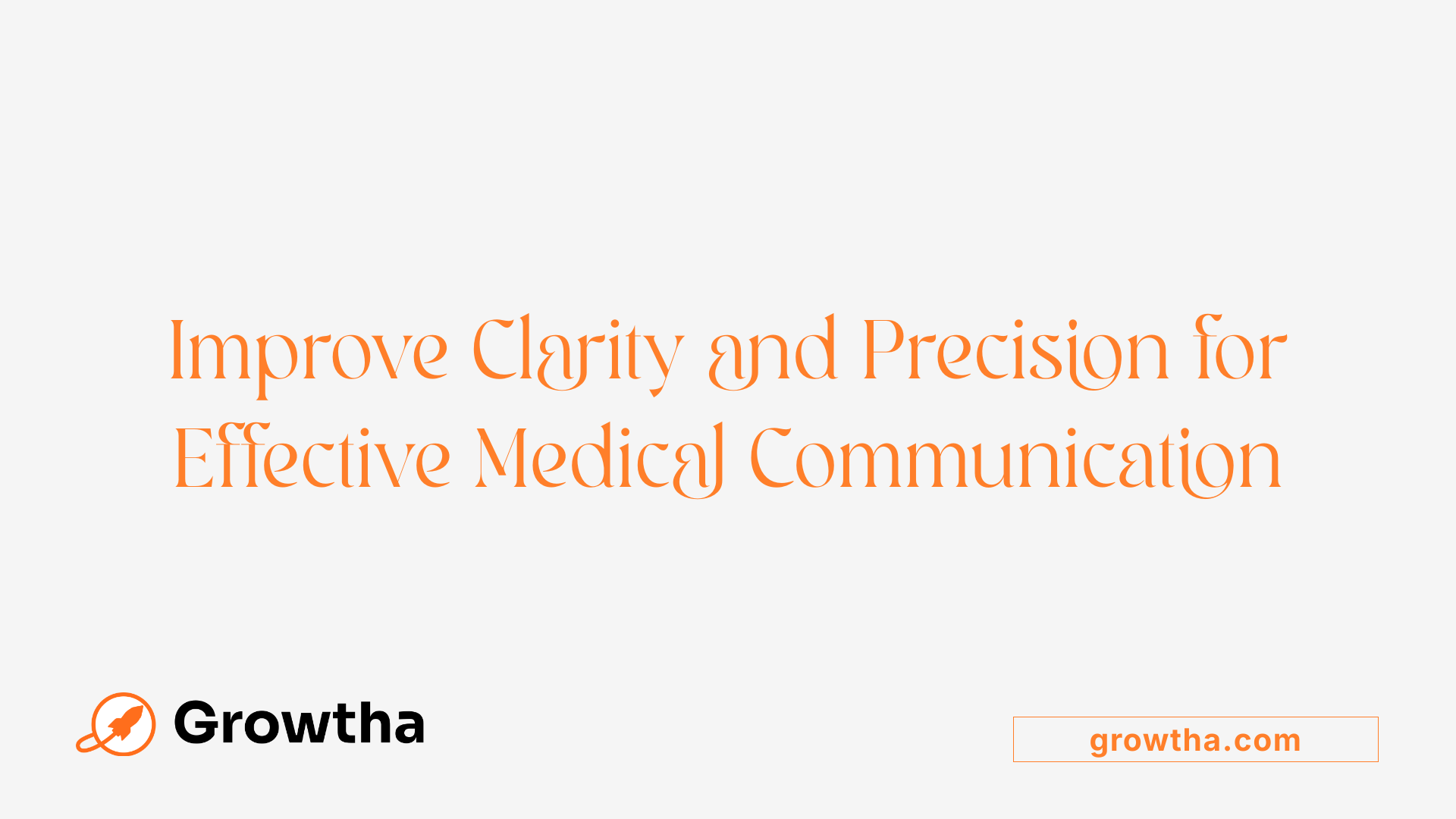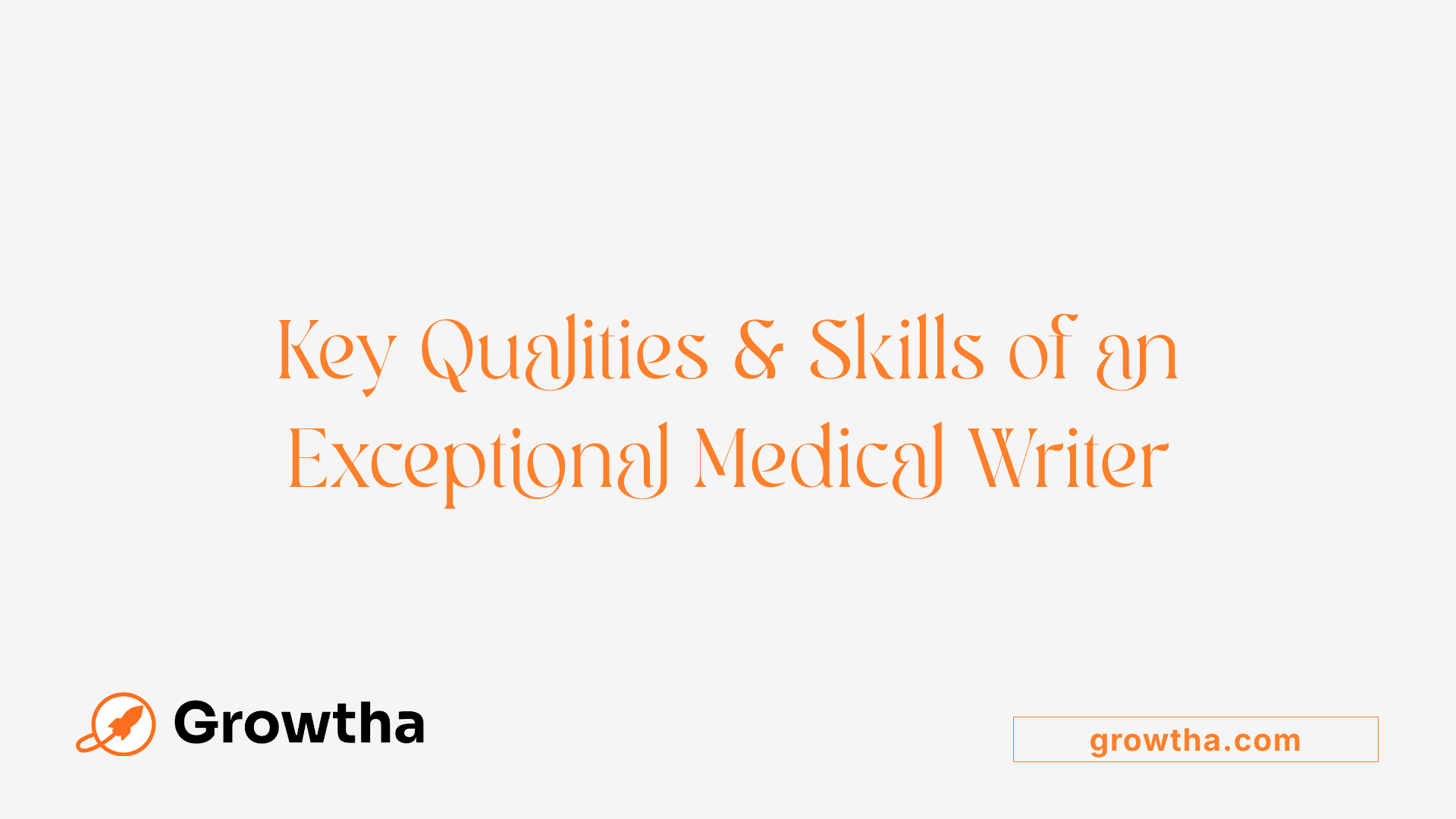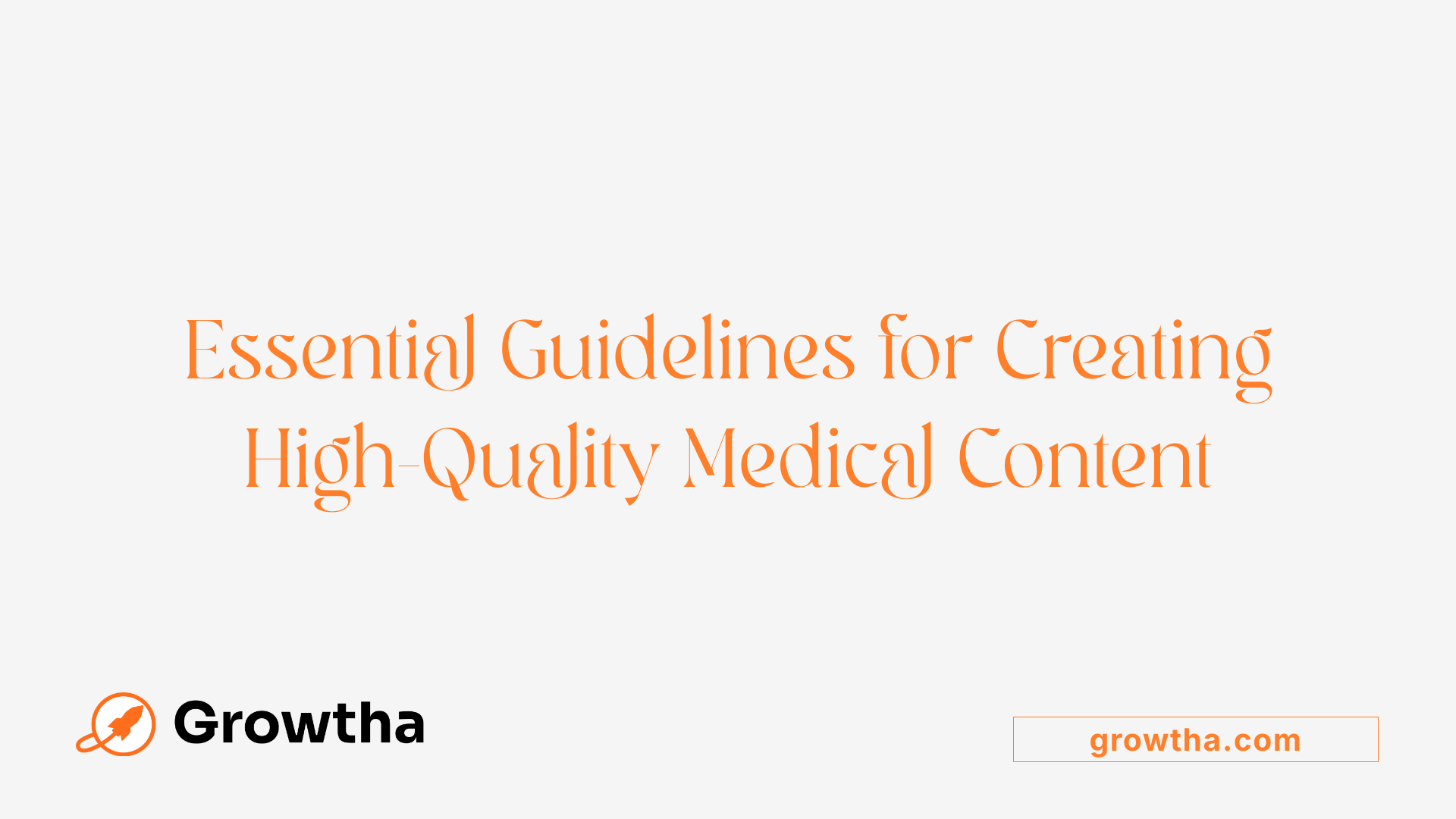Best Practices for Medical Content Writing
Mastering the Art of Medical Content Creation


Laying the Foundation for Effective Medical Writing
Medical content writing is a specialized skill that combines scientific precision with engaging communication. It requires understanding complex medical data, adhering to regulatory standards, and tailoring messages for diverse audiences, including healthcare professionals, regulators, and patients. This article explores the essential best practices to elevate your medical writing, ensuring clarity, accuracy, and effectiveness across various platforms and formats.
Starting with Structured Templates and Source Material

What are the essential skills for medical writing?
Medical writing demands a combination of scientific expertise and communication skills. Essential skills include a solid understanding of medical and scientific terminology, which enables writers to accurately interpret complex data and research findings. Data interpretation skills are also critical, helping to analyse tables, graphs, and clinical trial results effectively.
Beyond technical knowledge, medical writers must excel at organizing and presenting information clearly and concisely. This involves crafting content tailored to diverse audiences such as healthcare professionals, regulators, or patients. Attention to detail is vital to ensure factual accuracy and prevent errors in data or medical terminology.
Proficiency with regulatory guidelines and familiarity with clinical research processes enhance a writer’s ability to produce compliant documents. Skills in literature searching and understanding legal, ethical, and confidentiality standards further strengthen their role.
Effective time management, project organization, and familiarity with writing tools like Microsoft Word and reference managers support the development of well-structured, professional documents.
Continuous learning through training, networking, and reviewing scientific literature is essential to stay current with industry trends and evolving guidelines. Interpersonal skills, including collaboration with subject matter experts, contribute to high-quality content production.
Finally, strong editing capabilities and a keen eye for detail are important to refine drafts and ensure clarity, consistency, and compliance, ultimately producing credible and impactful medical documentation.
What are the principles for effective medical writing?
Effective medical writing hinges on principles of clarity, accuracy, and simplicity. The primary goal is to communicate complex scientific information in a way that is understandable to different audiences, which can range from doctors and researchers to the general public.
Using plain language and avoiding unnecessary jargon helps make content accessible. When technical terms are necessary, they should be clearly defined. Short sentences and logical structuring aid readability and retention.
Good medical writing also entails a thorough understanding of the subject matter, including medical concepts, research data, and relevant ethical standards. Adherence to international and regulatory guidelines such as ICH, GPP, or ICMJE ensures compliance and credibility.
Effective data visualization using tables, charts, and graphs makes data interpretation straightforward. Logical sequencing of content with clear headings and subheadings guides the reader through complex information.
Tailoring content to suit the target audience improves relevance; for example, regulatory documents require detailed and precise language, while patient educational materials benefit from a more accessible tone.
Maintaining accuracy through proper referencing and ensuring content is evidence-based adds to the trustworthiness of the document. Ethical considerations include avoiding bias, managing conflicts of interest, and maintaining confidentiality.
Incorporating technological tools like AI-supported editing or readability software can enhance quality. Ultimately, good medical writing is a balanced combination of scientific rigor and effective communication.
How do source materials and data analysis contribute to high-quality documents?
Thoroughly reviewing source materials such as research protocols, statistical analysis plans, and clinical data ensures that all information is accurate and up-to-date. This foundation is crucial for creating credible documents that stand up to scrutiny.
Analyzing data from tables, figures, and listings helps in understanding research results and identifying key messages to highlight in reports and publications. This process assists in planning content structure and revising drafts to ensure clarity and logical flow.
Effective data analysis involves not just reviewing numbers but interpreting their implications within the context of the study objectives. It allows writers to summarize findings appropriately, support claims with evidence, and visualize data effectively.
Using adapted visual tools like well-designed tables and figures makes complex data more comprehensible, aiding the audience’s understanding and retention.
In summary, a meticulous review of source materials and thoughtful data analysis are critical steps in producing high-quality, precise, and convincing medical documents. They underpin the integrity of the information conveyed, ensuring the document’s reliability and scientific value.
Enhancing Clarity and Precision in Medical Documents

How can medical writers improve clarity and precision in their writing?
Medical writers can bolster the clarity and accuracy of their documents by focusing on presenting study findings in a transparent and straightforward manner. Utilizing simple, active language avoids ambiguity, making content more accessible to a broad audience, including healthcare professionals, regulatory authorities, and patients.
Adhering to established publication standards—such as Good Publication Practice (GPP) and guidelines from the International Committee of Medical Journal Editors (ICMJE)—ensures consistency and compliance. Employing a logical structure, with clear headings and well-organized sections, helps readers navigate complex topics.
Incorporating visual aids like tables, charts, and figures simplifies data presentation, highlighting key points effectively. Proper referencing of sources not only supports credibility but also facilitates verification and transparency.
Engaging professional medical writers and editors can provide an extra layer of review, catching errors and improving language. Additionally, tailoring content to the target audience’s level of understanding enhances engagement and comprehension. Overall, the goal is to communicate scientific and clinical information accurately, ethically, and clearly—an essential aspect of trustworthy medical documentation.
What qualities distinguish a good medical writer?
A proficient medical writer combines technical expertise with excellent communication skills. Deep knowledge of medical terminology, research methodologies, and regulatory frameworks is fundamental to ensure correctness and compliance.
Attention to detail is critical, as even minor inaccuracies can significantly impact the credibility of a document. Good writers are also time-efficient and organized, often managing multiple projects while meeting deadlines.
Collaboration skills are equally important, as medical writers often work with researchers, clinicians, and regulatory specialists. Flexibility and adaptability allow them to work across different document types, from regulatory submissions to educational materials.
Ethical integrity, including understanding confidentiality, avoiding conflicts of interest, and maintaining transparency, upholds the standards of medical writing. They are also lifelong learners, staying updated with latest medical developments, guidelines, and best practices.
In essence, outstanding medical writers are not just skilled linguists but also strategic thinkers and ethical professionals committed to advancing medical knowledge and patient care.
Qualities of an Excellent Medical Writer and Their Skills

What qualities distinguish a good medical writer?
A top-tier medical writer is distinguished by a combination of technical proficiency, communication ability, and ethical standards. They have a deep understanding of complex medical and scientific concepts, terminology, and the regulatory landscape, which ensures that all documents are accurate, compliant, and trustworthy.
Clear and effective communication is essential. Medical writers must translate intricate research, clinical data, or regulatory information into well-structured, understandable content tailored to the target audience. Whether writing for healthcare professionals, patients, or regulatory agencies, adaptability in tone and style is crucial.
Attention to detail cannot be overstated. A good medical writer meticulously reviews content to avoid errors, inconsistencies, or omissions that could compromise data integrity or regulatory approval.
Strong organizational skills and project management capabilities enable writers to handle multiple assignments simultaneously, meet deadlines, and collaborate efficiently with multidisciplinary teams including doctors, scientists, and subject matter experts.
The profession demands adherence to high ethical standards. Maintaining confidentiality, promoting objectivity, and avoiding bias or unauthorized influence are fundamental principles of quality medical communication.
Additional skills include familiarity with research methods, data interpretation, and technical guidelines like ICH, FDA, and GPP standards. Crafting documents such as clinical study reports, regulatory submissions, educational materials, and promotional content requires a blend of scientific knowledge and linguistic skill.
Ultimately, an exceptional medical writer combines expertise, professionalism, and creativity, driven by a genuine desire to advance medical understanding and improve health outcomes.
| Skill Area | Description | Relevance |
|---|---|---|
| Medical Knowledge | Deep understanding of medical concepts, terminology, and data | Ensures accuracy and compliance in all documents |
| Communication Skills | Ability to convey complex info clearly and engagingly | Reaches diverse audiences effectively |
| Attention to Detail | Precision in reviewing and editing content | Prevents errors and maintains data integrity |
| Ethical Standards | Promoting honesty, confidentiality, and objectivity | Builds trust and ensures regulatory compliance |
| Project Management | Handling deadlines, prioritization, and collaboration | Facilitates efficient workflow |
| Research & Data Interpretation | Analyzing and presenting research findings effectively | Supports accurate and persuasive content |
Understanding these core qualities enables medical writers to produce high-quality scientific documentation that meets the demanding standards of the healthcare and pharmaceutical sectors.
Guidelines for High-Quality Medical Content Creation

What are some key guidelines for medical content writing?
Creating effective medical content requires strict adherence to principles that ensure the material is accurate, clear, and engaging. First and foremost, prioritize clarity and accuracy in all communication. This means presenting evidence-based information that is up-to-date and verified through reputable sources. Incorporating recent research and well-documented data helps establish trust and credibility.
Avoid unnecessary use of jargon and complex medical terms whenever possible. If technical language is essential, define these terms explicitly to help lay readers and professionals alike understand the content without confusion. Clear, straightforward language makes complex topics more accessible and reduces the risk of misinterpretation.
Writing style also plays a crucial role. Use active voice and avoid convoluted sentence structures. A direct and simple approach not only enhances readability but also keeps the reader engaged. Short sentences and familiar terms make the message more relatable and easier to digest.
Evidence-based content is fundamental in healthcare writing. This involves citing current research, studies, and guidelines to support statements. Proper referencing not only backs up claims but also guides readers to further detailed information, demonstrating professionalism and responsibility.
Finally, adopt a patient-centered perspective where appropriate. Focus on providing practical, relevant information that addresses the needs, questions, and concerns of the target audience, whether they are healthcare professionals or patients. This approach enhances the impact and usefulness of the content, promoting better understanding and engagement.
By following these guidelines, medical writers can produce high-quality content that informs, educates, and builds trust among diverse audiences, ultimately supporting better health outcomes and informed decision-making.
Leveraging Technology and Continuous Improvement

How can medical writers improve clarity and precision in their writing?
Medical writers can significantly enhance clarity and precision by focusing on how they present their data and ideas. Clear presentation of research findings is fundamental, which involves using straightforward, unambiguous language and structuring the document logically. Employing active voice makes statements more direct and easier to comprehend.
Simplifying technical jargon without sacrificing accuracy ensures that content is accessible to a broader audience, including healthcare professionals, regulatory bodies, and patients. Adhering to established publication standards such as Good Publication Practice (GPP) and the International Committee of Medical Journal Editors (ICMJE) guidelines is vital for consistency and credibility.
Engaging professional medical writers or editors can further boost quality, ensuring that language, style, and content meet high standards. They also help reduce ambiguities, correct errors, and align documents with ethical requirements.
Using visual aids like charts, tables, and figures can make complex data more digestible, supporting effective communication. Proper referencing of all sources adds to transparency and allows readers to verify information.
At the core, continuous commitment to accuracy, transparency, and audience understanding creates precise and effective medical documentation. Regular training on new standards, tools, and best practices can help writers stay at the forefront of this evolving field.
Using advanced writing tools and software
The deployment of specialized writing tools and software is a game changer for medical documentation. Programs like EndNote or Zotero streamline citation management, ensuring references are accurate and properly formatted.
Document editing and proofreading tools, such as Grammarly or Hemingway Editor, assist in identifying grammar issues and improving readability. Medical writing software, like Primo or MasterControl, can help ensure compliance with regulatory formats and standards.
Artificial intelligence (AI) and machine learning applications are increasingly integrated into editing tools, providing suggestions for clarity, consistency, and even real-time fact-checking. These innovations reduce manual errors and improve workflow efficiency.
Medical writers should also familiarize themselves with data visualization software like GraphPad Prism, Tableau, or Microsoft Excel, for creating clear and compelling figures that support their narrative.
Staying current with medical and regulatory developments
Healthcare and regulatory landscapes are constantly changing. Staying informed about the latest clinical trial results, new therapies, and regulatory updates ensures content accuracy and relevance.
Regularly reviewing reputable sources such as the FDA, EMA, WHO, and top medical journals helps writers understand current standards and emerging trends. Joining professional organizations like the AMWA or EMWA provides access to webinars, newsletters, and conferences focused on the latest in medical writing and regulation.
Following updates in guidelines such as ICH E6 (good clinical practice) or ICMJE recommendations equips writers to produce compliant documents.
Understanding recent advances in research methodologies, data analysis, and patient-centric approaches enhances the relevance and credibility of healthcare content.
Regularly updating healthcare content
Healthcare information must be current to maintain trust and compliance. Regular updates involve reviewing existing content for new evidence, correcting inaccuracies, and adding recent data.
This continuous process helps prevent dissemination of outdated information that could lead to misinformation or legal implications. It also enhances search engine rankings, as search algorithms favor fresh, relevant content.
Scheduling periodic content reviews, using analytics to identify underperforming content, and integrating new insights from ongoing research are best practices.
Employing content management systems (CMS) with versioning capabilities enables efficient updates and historical tracking. Collaborating with subject matter experts ensures that modifications are accurate and scientifically sound.
In sum, harnessing advanced tools, staying informed, and maintaining current content form the backbone of high-quality medical writing that effectively educates, engages, and supports healthcare decision-making.
The Seven Steps to Impactful Medical Writing

What are some key guidelines for medical content writing?
Creating effective medical content requires strict adherence to several essential guidelines. Foremost, clarity and accuracy are paramount. Content should be based on the latest evidence, citing reputable sources and current research to establish credibility and trust. When presenting complex medical information, avoid unnecessary jargon and technical language; if technical terms are necessary, define them clearly to ensure understanding.
A straightforward, active writing style tends to be more engaging. Writing in a clear, direct manner makes information accessible, especially for diverse audiences, including patients, healthcare professionals, and regulatory bodies.
Additionally, content should always prioritize a patient-centered approach—aim to provide practical, relevant information that addresses the needs and questions of the target audience. This approach not only improves engagement but also enhances the usefulness and real-world application of the content.
By following these guidelines, medical writers can produce trustworthy, effective documents that inform, educate, and support healthcare decision-making.
How does a structured approach improve medical writing?
Employing a systematic, seven-step process ensures that medical writing is impactful, credible, and tailored to its audience. Here's an overview of each step:
| Step | Focus Area | Details |
|---|---|---|
| 1. Accuracy | Use of evidence-based facts | Incorporate current data, verify references, avoid outdated or biased information. |
| 2. Clarity | Simplify complex ideas | Break down technical jargon, use clear language, and support explanations with visuals or analogies. |
| 3. Guidelines | Compliance with standards | Follow regional and international regulations like ICH, GPP, and ICMJE. |
| 4. Referencing | Proper citation practices | Include precise references for verification, demonstrating transparency and credibility. |
| 5. Ethics | Uphold integrity | Maintain confidentiality, disclose conflicts of interest, and avoid exaggeration. |
| 6. Audience Focus | Tailor content for relevance | Understand reader needs—patients need reassurance, professionals prefer detailed scientific data. |
| 7. Structure | Logical organization | Use headings, bullet points, and visuals to organize information and improve readability. |
How do these guidelines translate into practical steps?
Starting with thorough research, medical writers should gather data from reputable sources, interpret clinical trial results accurately, and incorporate creative storytelling where appropriate. This is complemented by diligent editing—reading the draft aloud, seeking peer feedback, and using readability tools to ensure accessibility.
Effective formatting plays a vital role. Clear headings, bullet points, tables, and visuals help present information neatly, guiding the reader through complex content. Proper use of metadata, keywords, and mobile-friendly design enhances SEO, making content more discoverable.
Finally, disciplined review and ongoing updates are crucial for maintaining content relevance and accuracy. Regularly monitoring performance through analytics, collecting feedback, and updating content ensures sustained engagement and trust.
How can understanding medical writers’ roles improve document quality?
Medical writers are responsible for bridging the gap between scientific data and understandable content. They must possess a mix of scientific knowledge, writing skills, and regulatory understanding. Working closely with healthcare professionals ensures that the information is accurate, complete, and compliant.
Proficiency in using writing and referencing tools, along with a thorough knowledge of regulatory standards, makes the process more efficient. Continuous learning—through certifications such as those from AMWA—and networking with peers enhance skill sets.
In summary, implementing a structured, guideline-driven approach empowers medical writers to produce high-quality content that is trustworthy, engaging, and impactful—ultimately advancing healthcare communication and patient care.
Achieving Excellence in Medical Content
In the realm of medical content creation, adherence to best practices ensures the development of credible, clear, and engaging documentation. By embracing structured templates, thorough research, ethical standards, and continuous learning, medical writers can produce content that meets regulatory requirements, educates audiences, and advances healthcare communication. Integrating technology, employing effective storytelling, and maintaining a patient-centered approach further enhance content value. Ultimately, mastery of these principles fosters trust, clarity, and impact in medical writing, contributing to better health outcomes and informed decision-making.
References
- Five Tips for New Medical Writers
- Content Writing for Medical Practices
- The Ultimate Guide to Healthcare Content Writing - Aha Media Group
- 6 Steps to Writing Engaging Healthcare Content | Matter Blog
- Ultimate Guide to Becoming A Medical Writer
- Uptake's Seven-Steps to Impactful Medical Writing
- 10 Tips for Selecting a Medical Writer | Global Resourcing Provider
- How to Become a Competent Medical Writer? - PMC







